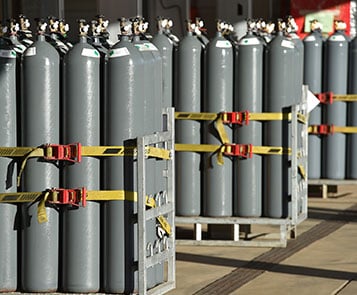Biotech EHS Managers: Prioritize Top Talent!
The life sciences industry faces major challenges that pull at already near-exhausted resources. Unfortunately, this can result in environmental, health, and safety (EHS) managers looking for short-term gains by skimping on talent acquisition, nurturing, and retention.
Cutting costs by reducing EHS team member headcount is a mistake, however—and a potentially fatal one. That applies especially for fledging R&D organizations looking to:
- Safely and efficiently innovate
- Secure approvals
- Go to market
Just one safety violation, fine, or shutdown can be a deal-breaker, involving missed deadlines, bad publicity, and more.
Get the Best EHS Talent, the Easy Way
Fortunately, as this blog has noted, there are ways to secure the best EHS specialists without incurring the expense and risk of full-time hires. EHS outsourcing involves partnering with a top EHS services provider who offers outstanding team members. Such a partner should employ seasoned industry professionals who can deliver specialized onsite support services that prevent noncompliance, operational disruptions, and delays.
That was the key message of Triumvirate Environmental’s recent webinar, “Biotech EHS Programs Risk Failure Without the Right People: Don't Skimp on Talent!” The event featured two top life sciences EHS experts, Mike Albert, EHS Director and EHSOne® Program Owner, and Judy Tilden, the Director of Life Sciences for Professional Services.
Life Sciences Industry Challenges
During the webinar, Albert and Tilden discussed the unique challenges facing the EHS industry (which was also the primary subject of one of our prior blogs). Some of the major systemic industry-wide changes include the:
- Drop in demand for COVID-19 vaccines and antivirals
- Looming industry patent cliff
- Weak biotech initial public offering (IPO) market
- Lack of financing sources—including venture capital funds
- Hiring of full-time, experienced EHS employees is as tough, risky, and expensive as ever
The absence of investor confidence is one of the biggest drivers reshaping the life sciences market today, says Albert. He travels nationwide extensively, and this remains true throughout the country. Biotech clients from New England to North Carolina and Maryland—and even west to Texas and California—are feeling the same seismic pressures.
“Investors are still nervous about what's going on,” he says “They're still seeing the stock market go up and down—we're coming up on an election year. So, there's a little bit of a nerve-wracking moment in there, as well.”
Fierce Pressure on EHS Operations
The worries extend to EHS operations, as well, as managers face tight budgets. Simultaneously, they aren't seeing demand reductions when it comes to offering outstanding support for rapidly expanding or maturing organizations.
The drive to produce the next new, profitable therapy is making life especially tough for biotech firms. This applies to all industry players, from R&D labs in incubators to midsized and profitable companies, and even to the largest enterprises. Only the best life sciences people can successfully innovate—compliantly, on time, and within budget.
“But really now, it's all-around time to buckle down,” says Albert. “Get these therapies approved, get these drugs pushed forward, understand that these Food and Drug Administration (FDA) trials don't occur overnight. They take a little bit longer than that, and you have to make sure that the right people are in place to be able to push it through.”
The EHS staff are key props to R&D, sales, and so on, and despite their internal priorities, their overall organizational goal is still the production of successful therapies. “We need to make sure we're keeping that research going,” says Tilden. “Without the research, we're all out of jobs.”
EHS Human Resources Challenges
People are a major problem. As Albert explains: “In seeing what's going on from last year to this year, understanding that biotech operations management not only is challenged with growth, but challenged with downturn and with saving money over time as well." Additionally, "Obviously, hiring top talent is not only huge, but it is catastrophically hard when you lose somebody.”
Another factor affecting managers is applicant demographics. The talent pipeline for biotech EHS professionals is producing younger candidates—which is “wonderful,” says Albert. But while these individuals are the future face of the industry, they lack crucial experience. So, the pool of available, trained, and experienced EHS pros is as shallow as ever.
Hiring and keeping top EHS team members remains challenging and costly. Top employee candidates are rare—and the biggest biotech clusters (like Boston-Cambridge, San Diego, San Francisco-Silicon Valley, and New York City) are among the most expensive locations to live in. But the nature of biotech work demands employees remain in the area, working in person—so salaries must be commensurate with these expensive regions.
The Right Staff Mix: A Moving Target
Recruitment and hiring are just one set of major talent challenges, along with training, retention, and more. Managers must spend time and treasure throughout the entire employee acquisition lifecycle—on top of salary, a full-time hire costs thousands of dollars to hire. And that’s without even factoring in the price of on-boarding, training, cultural assimilation—as well as various administrative costs.
It gets even more complex. The needs for talent will vary depending on the organization’s status—where it’s at in the product creation and distribution lifecycle. So, a large enterprise EHS manager may worry about having touchpoints on the frontline.
On the other hand, a smaller company must do as much as possible on the back end, with limited cash and administrative resources. And at any moment, the organization may be scaling and needing more assistance—or scaling down after R&D is concluded. What then?
Moreover, EHS managers must prioritize not just successful operations for R&D, production, and marketing—but also protecting their people, as Tilden explains. “It's the health and safety of the people there and making sure that those are always on the forefront.”
Clearly biotech managers are in a squeeze.
Partners for EHS Life Sciences Success
One way to get the best people—with limited risk and reduced and transparent cost—is to secure talent via a partnership with a top-tier EHS services company. This doesn’t mean managers eliminate in-house team members—rather, they must decide what is core and irreplaceable to EHS operations. Then they must decide what they want to augment, and for how long, and with how many external specialists.
Among the advantages of partnership staffing:
- An organization can pull in a fully trained EHS professional for near-immediate deployment.
- Managers have a choice—they can select both full-time and part-time partner team members, as needed.
- An organization can be much more flexible in terms of securing talent—managers hire particular roles as needed (as in during a lab move or decommissioning) without any long-term commitments.
- Risk avoidance: any given full-time employee may or may not ultimately work out. If the latter, there was a great waste of time and money. Worse, any employee can also leave abruptly, taking all the education and institutional knowledge with them.
- Operations continue even if an employee is unavailable. A qualified partner will have a reservoir of cross-trained, experienced pros to step in at any time.
- A good partner will make client goals their goals—customer success is their success, and they can share their hard-won savvy and skills to get the client there.
Ultimately, as Albert explains, it’s a matter of sharing responsibilities and freeing up internal staff and managers to focus on core business projects. He says: “It comes down to: Don’t be selfish with accountability. Share it with trusted partners. Share it with the people who care.”
Reach Out to Triumvirate Environmental
Triumvirate Environmental is an all-around partner for life sciences organizations of all sizes and types. Want to learn more? We invite you to watch the full webinar on-demand and discover just what a top partner can do for you.
For smaller clients in incubation facilities, we offer JumpStart, a full EHS solution for growing operations. Midsized and enterprise-scale organizations can leverage our EHSOne® program. This turnkey offering contains a full portfolio of services planned and executed to simplify the client’s operations. It enables the organization to access one or many products through a single point of contact, simplifying life for internal EHS administrators and staff.
Talk to us today about we can help you.






